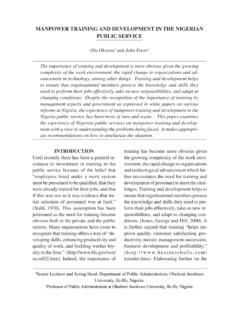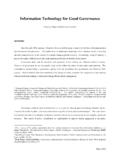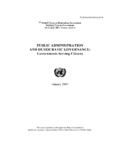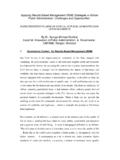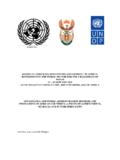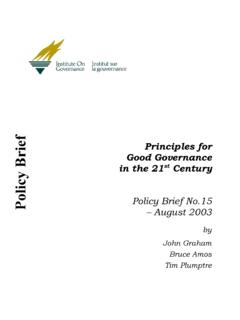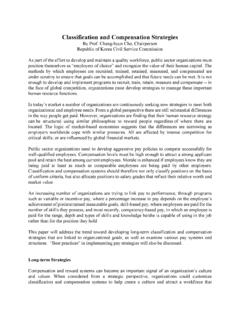Transcription of Leadership Models: From Weber to Burns to Bass
1 Leadership Models: From Weber to Burns to Bass Presentation Introduction Max Weber Model of Transactional and Transformational Leaders James MacGregor Burns Model of Transactional and Transformational Leaders Bernard M. Bass Model of Transactional and Transformational Leaders Bennis & Nanus Transformational Leaders Schein Culture Change as Transformation Introduction Introduction: From Weber to Burns to Bass Traits Behaviour Charisma Situation Transformational Leadership Max Weber 's Model of Transactional and Transformational Leaders Max Weber Asks how a leader can "legitimately" give a command and have actions carried out? Classified claims to the "legitimacy" in the exercise of authority Identified three kinds of leader/follower relations traditional, bureaucratic and charismatic Believe they occur in combination, and Also argues that "there may be gradual transitions between these types".
2 Max Weber 's three ideal types of leaders 1. Bureaucratic (Transactional). Bureaucracy is "the exercise of control on the basis of knowledge ; the Three Frames rational legal hierarchical power, the Bureaucratic Leader 3. Charismatic Hero 2. Traditional (Transformer) (Feudal/Prince). An individual personality set apart Traditional an arbitrary exercise from ordinary people and endowed of power bound to loyalty, with supernatural, superhuman favoritism, and politics; the powers and heroic charismatic princely Leadership qualities; part hero part leader superman/superwoman Rational Grounds (the bureaucrat). Rest on a belief in the 'legality' of patterns of normative rules and the right of those in authority to issue commands (legal authority).
3 Free of transaction, negotiation and bargaining for resources and power The "monocratic" and "modern" types much more transactional Operates in a transaction economy Highlights The leader subject to Each office defined by strict and systematic sphere of competence discipline and control in Person does not owe the conduct of the office obedience to the Claims to obedience individual, but to the based on rational values impersonal order and rules and Rules regulate the established by conduct of an office agreement (or (either technical rules or imposition) norms). The office holder Complete separation of restricted to impersonal property belonging to official obligations and the personal and to the commands organization Clearly defined hierarchy Officials, not persons exercise authority Examples The Catholic Church, Hospitals, Religious orders, Profit-making business, Large-scale capitalistic enterprise, Modern army, The modern state, Trade unions, and Charitable organizations Advantages and Disadvantages ADVANTAGES DISADVANTAGES.
4 Capable of attaining the Powerful interests co-opt highest degree of the offices and turn efficiency; them into feudal Technical efficiency; kingdoms;. Corporate control over Leveling in terms of coercive leaders; technical competence;. Favours the leveling of Tendency to plutocracy;. social classes Formalistic spirit of impersonality stunting enthusiasm and passion;. Duty over personal considerations Traditional Grounds (the Prince). Rest on an established belief in the sanctity of traditions and the legitimacy of the status of those exercising authority (traditional authority). Highlights Legitimacy and power to Promotion by the arbitrary control handed down from grace of the chief (no the past technical training of skill Power exercised in quite required).
5 Arbitrary ways Commands legitimized by Office held by virtue of traditions traditional status and by Obligations of obedience on recruiting favourites or by the basis of personal loyalty patrimony (kinship, or dependents). Obligations not by office Exercise of authority is only but personal loyalty to the limited by resistance; or, chief but pointing to a failure to Functions are defined in act according to the terms of competition traditions among the interest of those seeking favours, income, and other advantages Irrational division of official functions (established by rights or fees). Examples Ruling families, Feudal kingdoms in China, Egypt and Africa, Family business, Roman and other nobilities, Clans and, Armies of the colonies Disadvantages The following Bureaucratic facets are ABSENT.
6 Clearly defined sphere of competence subject to impersonal rules Rational ordering of relations of superiority and inferiority A regular system of appointment and promotion on the basis of free contract Technical training as a regular requirement Charismatic Grounds (the Hero). Rest on devotion to the specific and exceptional sanctity, heroism or exemplary character of an individual person, and Of the normative patterns or order revealed or ordained Highlights Obeyed by virtue of People are not promoted - personal trust, heroism or only called or summoned exemplary qualities on the basis of their Charisma regarded as of charismatic qualification divine origin, the person is No established treated as a leader administrative organs, no Hero worship system of formal rules, no Set apart from ordinary abstract legal principle people and endowed with Leader preaches, creates.
7 Supernatural and or demands new superhuman powers and obligations abilities Radically opposed to both Charismatic leaders choose rational and particularly members not for technical bureaucratic authority training, but on the basis of The biggest challenge - the social privilege and the charismatic administrative charismatic qualities of staff to transition to a disciples bureaucratic and rational administration ADVANTAGES. Escape the control of bureaucratic apparatus Escape the bonds of traditional inertia Weber 's Model None of the three ideal types occurs in "pure". form; transitions and combinations can be observed Can be a combination of bureaucratic, traditional, and charismatic Leadership The ideal (pure) types transmute one into the other Gradual transitions between the three types Weber 's transactional and transformational Leadership models Distinctions can be made between: Will to Power (Theory X) and Will to Serve.
8 (Theory Y);. Transactional and Transformational Leadership models X & Y Leader Model Enthusiasm for wielding power over others, resisting prince followers' power and being out Superman of the box X WILL to POWER. TRANSACTIONAL TRANFORMATIONAL. Enthusiasm for bargaining and Enthusiasm for new ENDS, and negotiating MEANS to attain ways to transform the world;. higher efficiency, and staying out of the box inside the box WILL to SERVE. Y. Enthusiasm for new ENDS, and ways to transform the world; out of the box bureaucrat hero James MacGregor Burns Model of Transactional and Transformational Leaders Burns Sets up a duality between amoral and moral leaders Morality drives the duality Only the moral leaders with higher purpose can be transactional or transformational leader Hierarchy coercive with a strong will to power moral means to lead the moral ends of Leadership The Amoral Leader Neither transactional or transformational.
9 An oxymoron Naked power-wielding can be neither transformational nor transactional; only Leadership can be.". Examples Mussolini, Hitler, Stalin The Moral Value Leader Emerges from, and always returns to, the fundamental wants and needs, aspirations, and values of the followers In responding to leaders, followers have adequate knowledge of alternatives and the capacity to choose among those alternatives Take responsibility for their commitments With higher purpose can be transactional or transformational leader, but in different ways (but never amoral). Two Moral Leaders Sub-Types Transactional Transformational Leaders Leaders lead with modal lead with values (the means transcendent values over ends) (the ends over Modal values means).
10 Include: Transcendent values Honesty include: Responsibility Liberty Fairness Justice Honouring one's Equality commitments Collective Well Being Transformational categories of Leadership 1. Intellectual Leaders Seeing ideas and values that transcend immediate practical needs and still change and transform their social milieu "The concept of intellectual Leadership brings in the role of conscious purpose drawn from values.. Out of step with their own time, in conflict with the status quo With a vision that transform society by raising social consciousness Transformational categories of Leadership 2. Reform Leaders Requires participation of a large number of allies with various reform and non-reform goals of their own Dealing with endless divisions in the ranks, and a collective - anti- Leadership Implies moral Leadership matching means to the ends Transform society to realize moral principles Transformational categories of Leadership 3.

